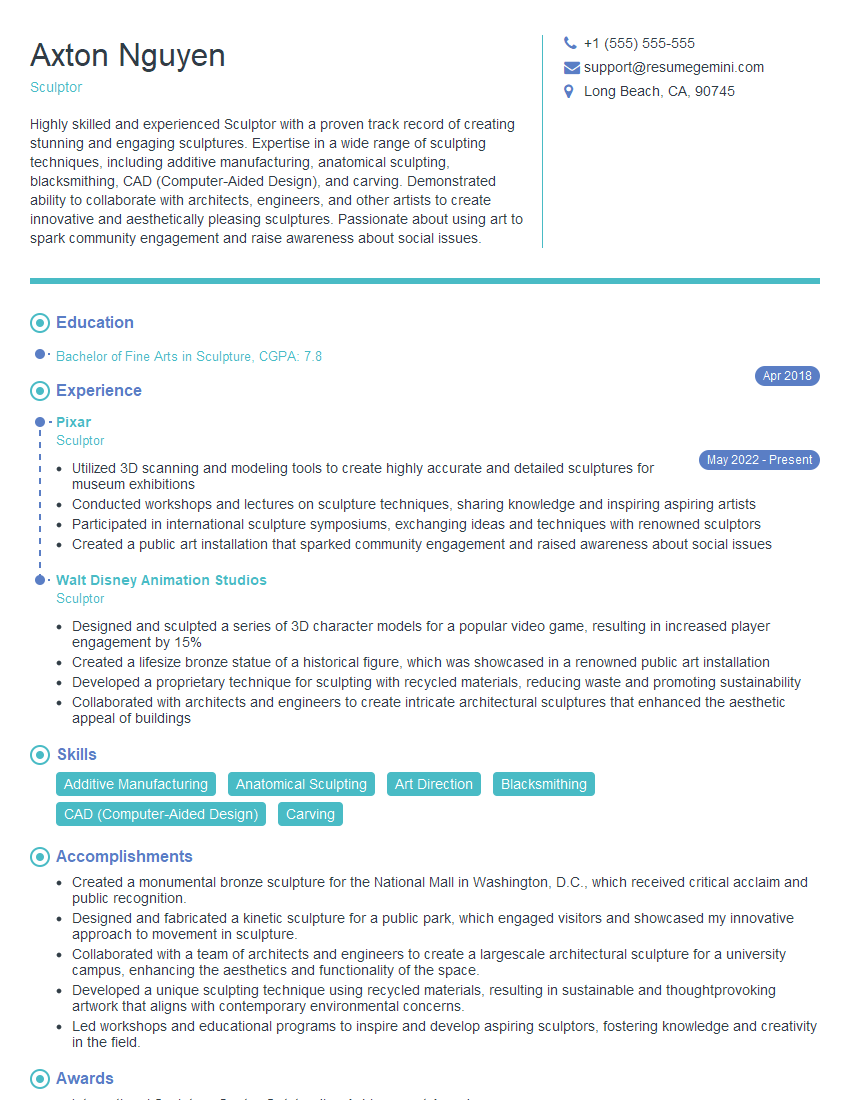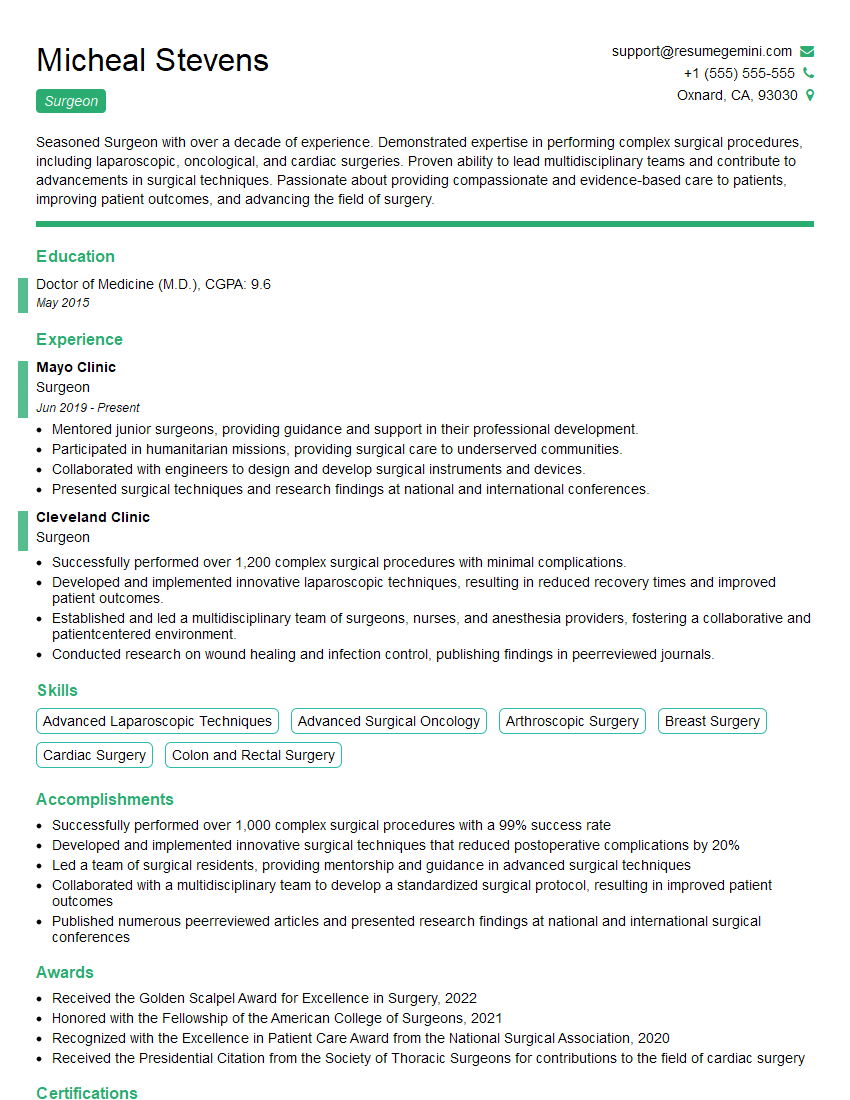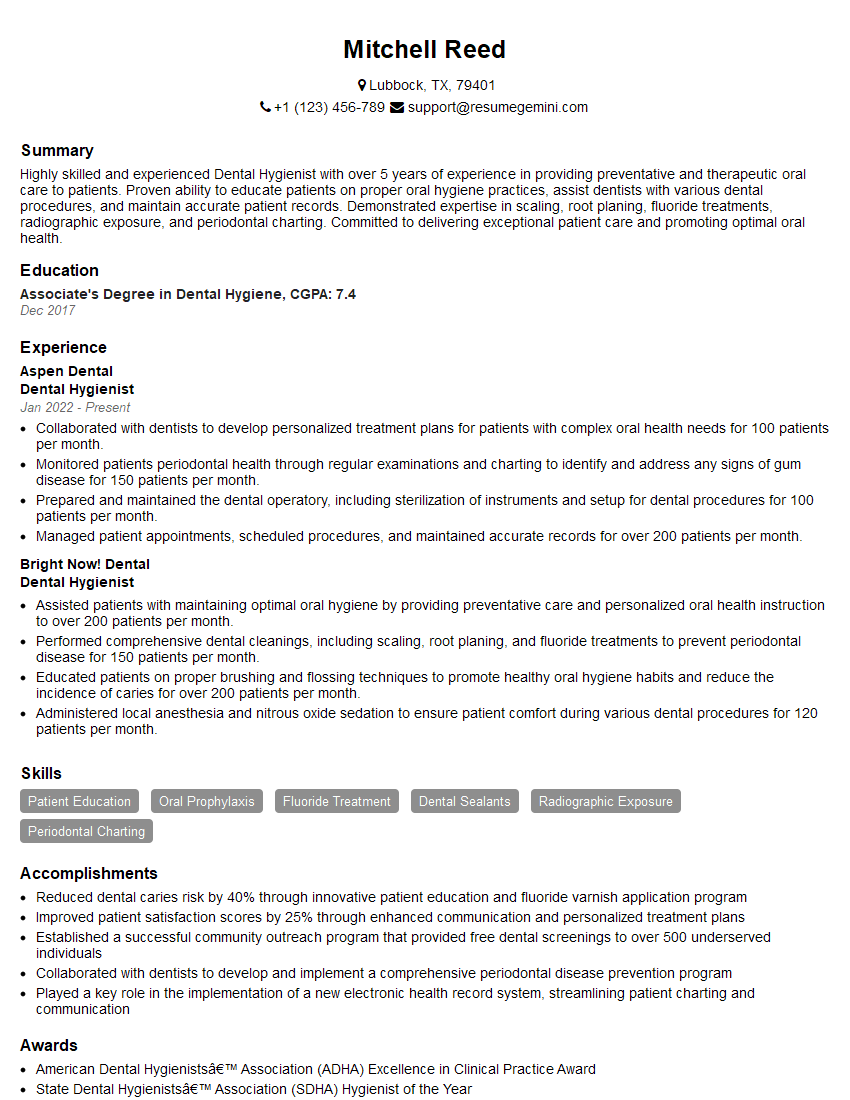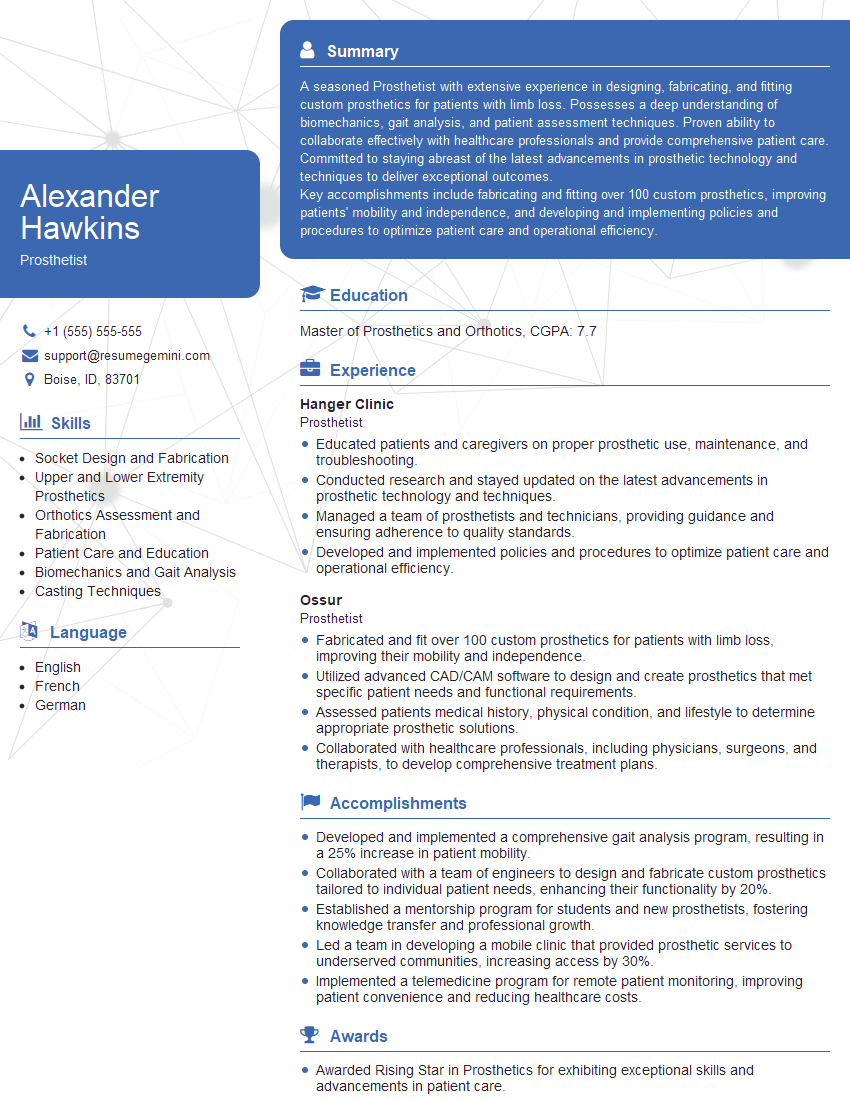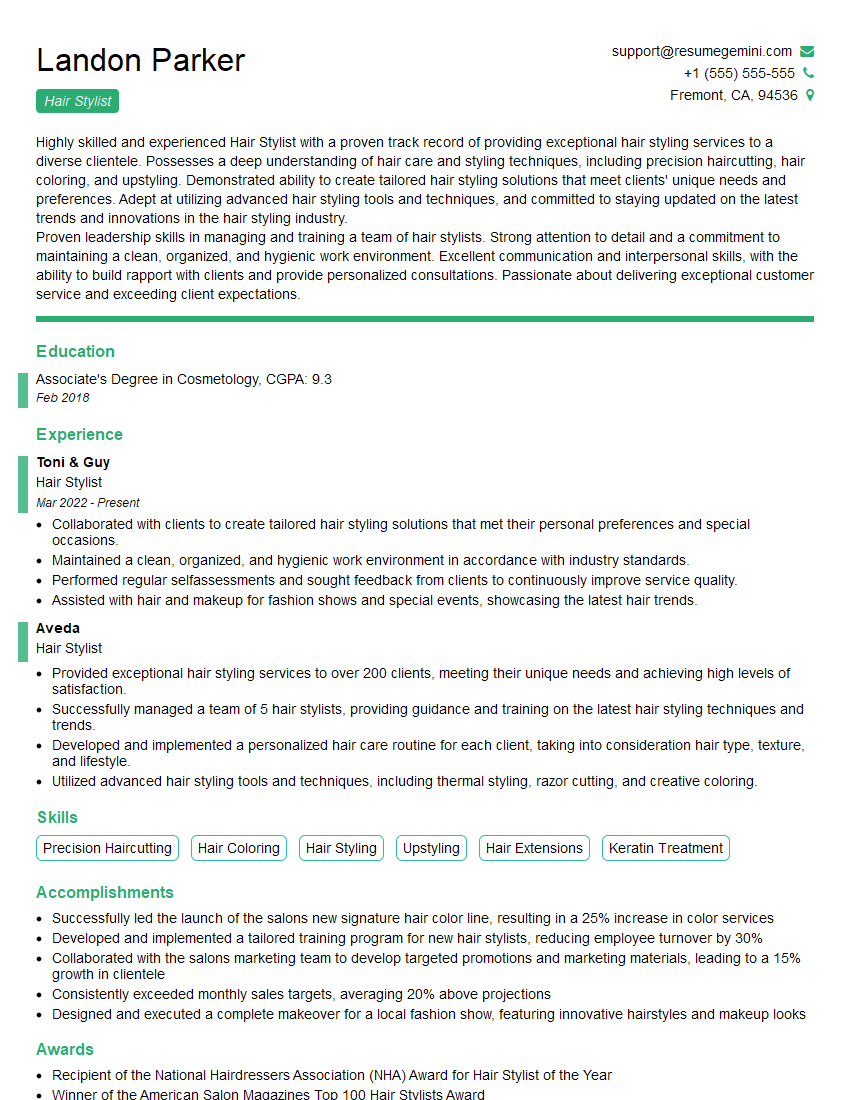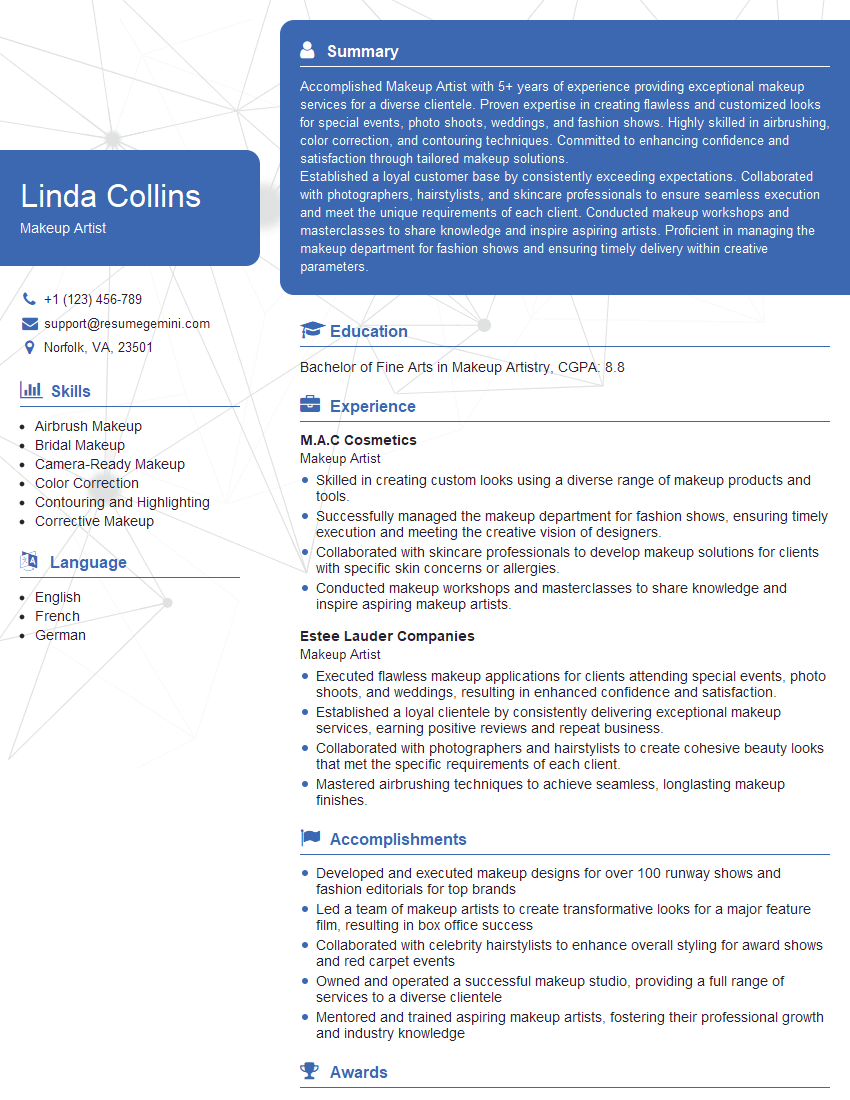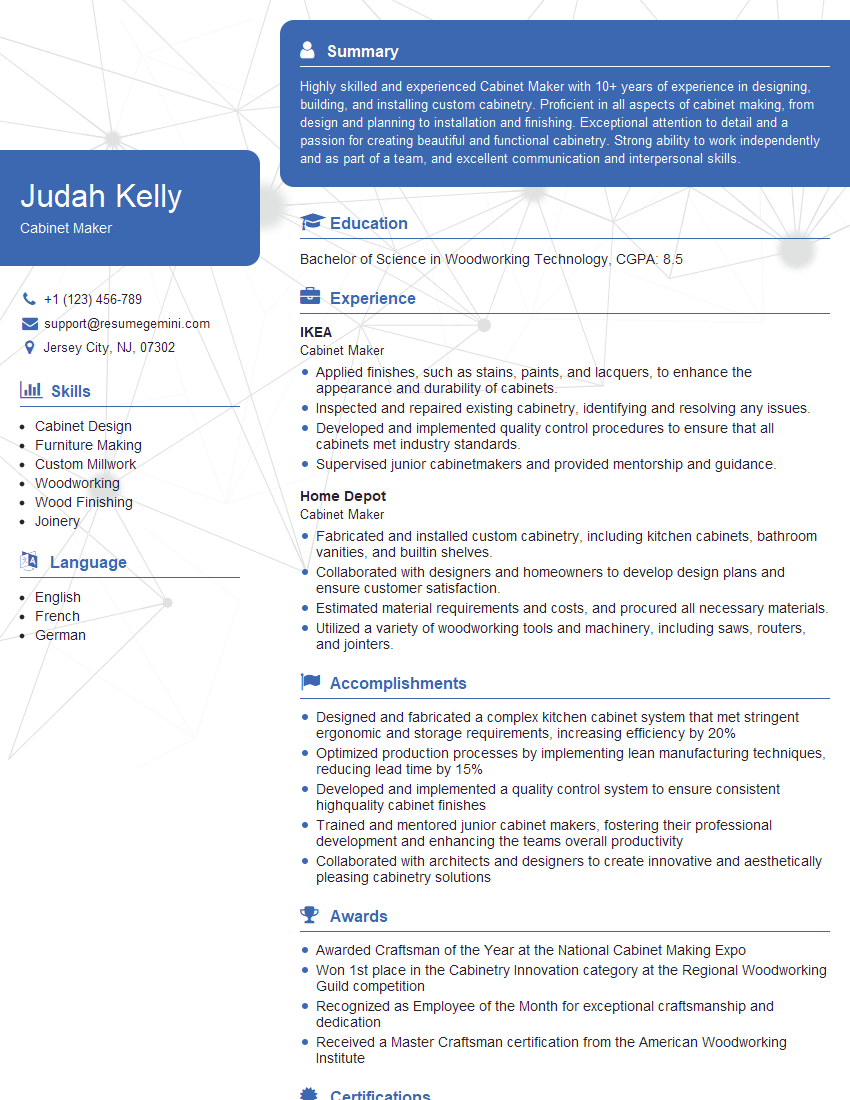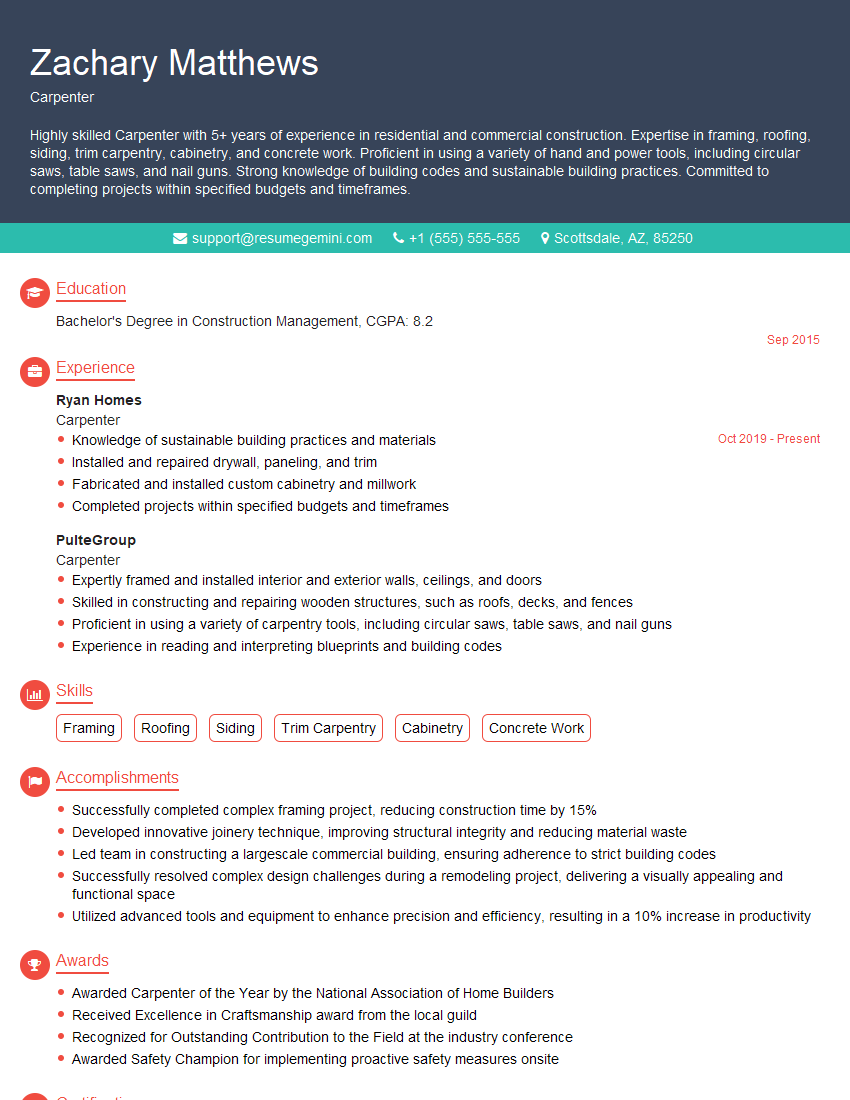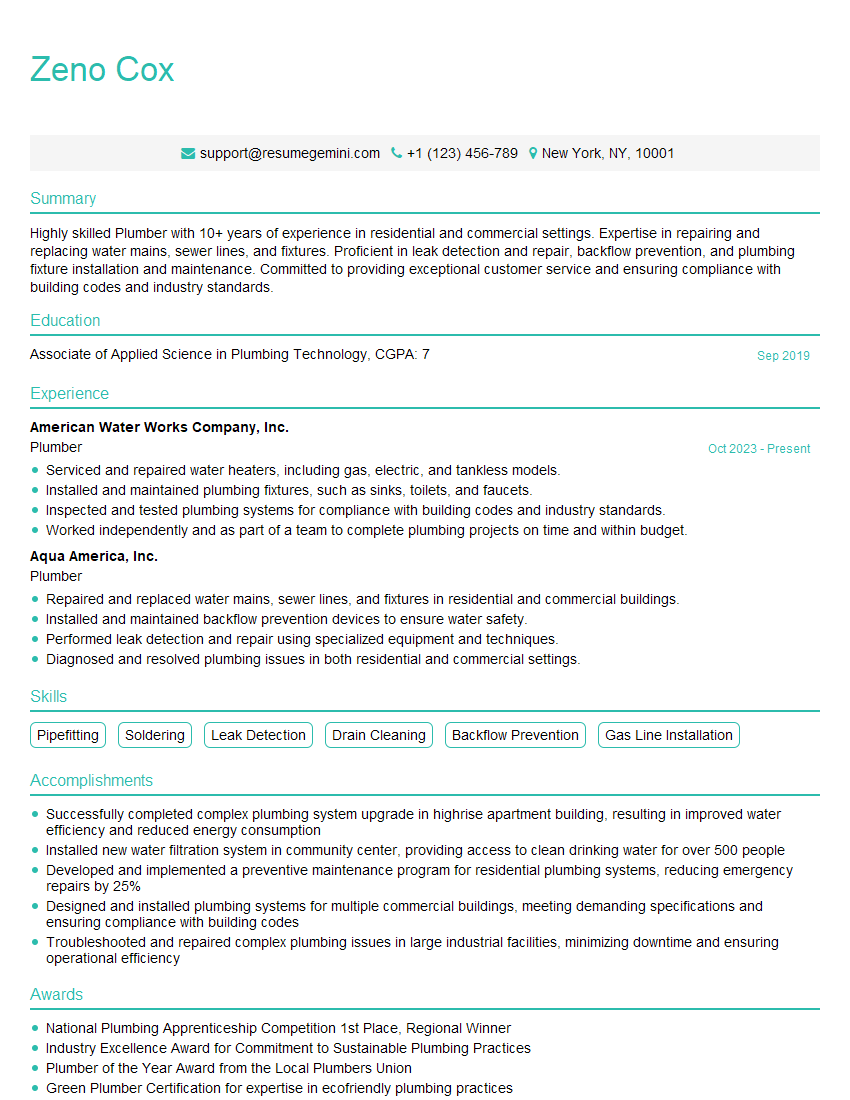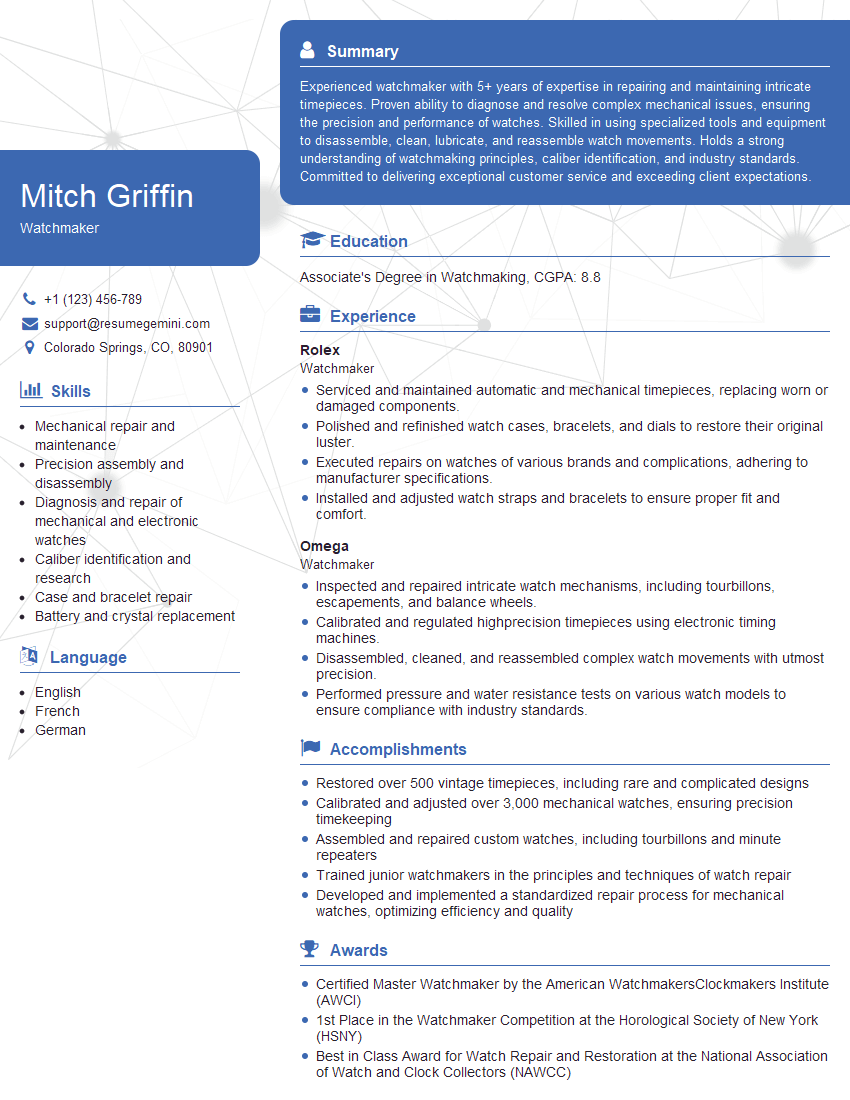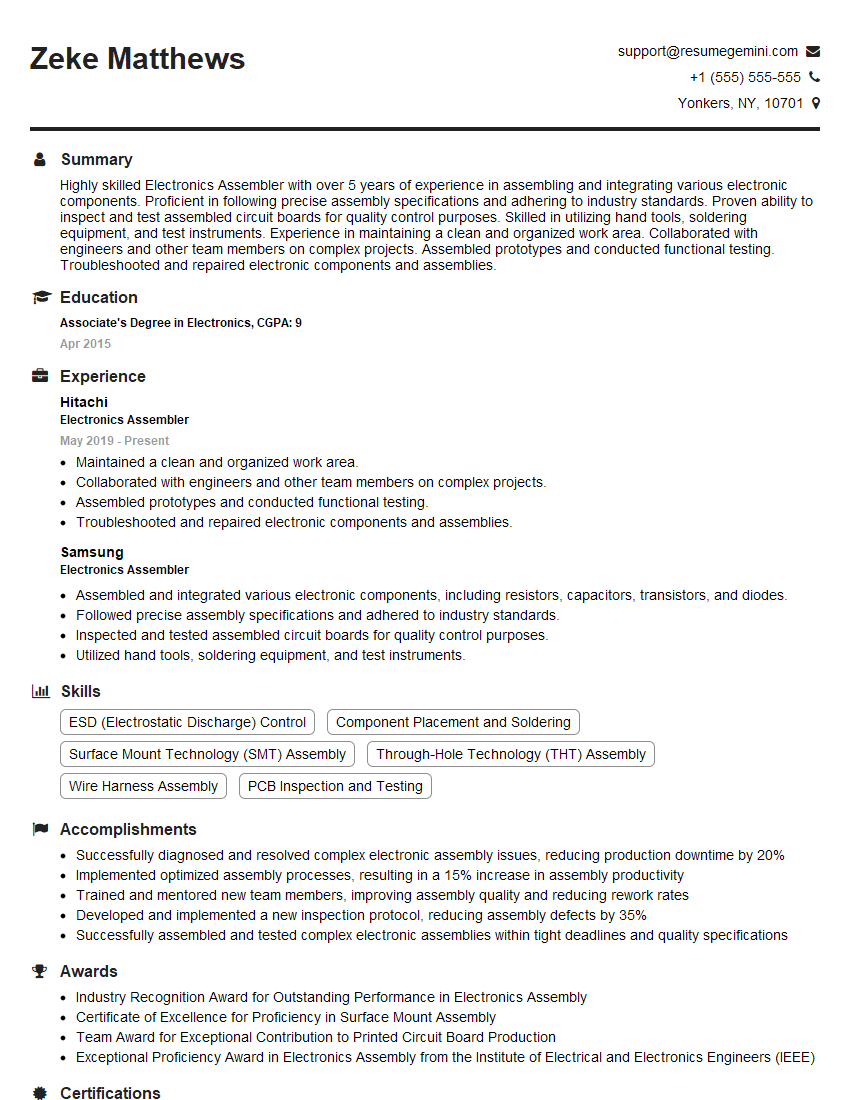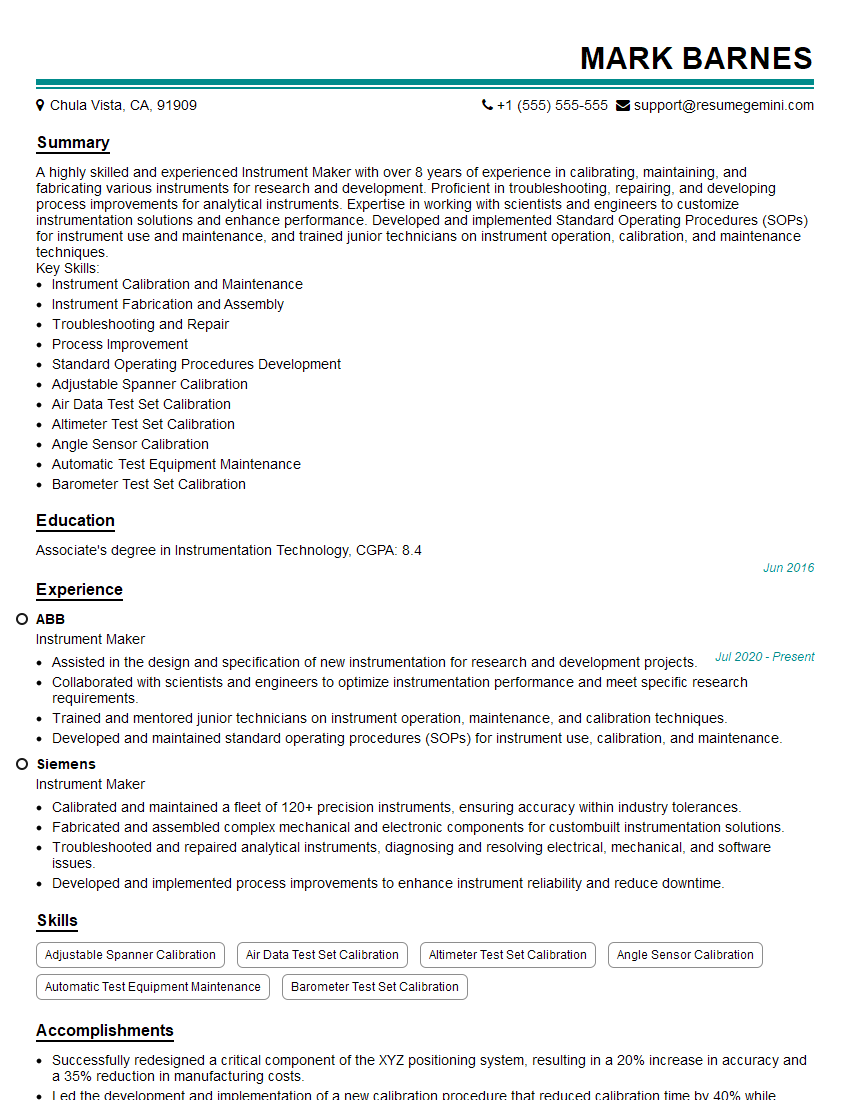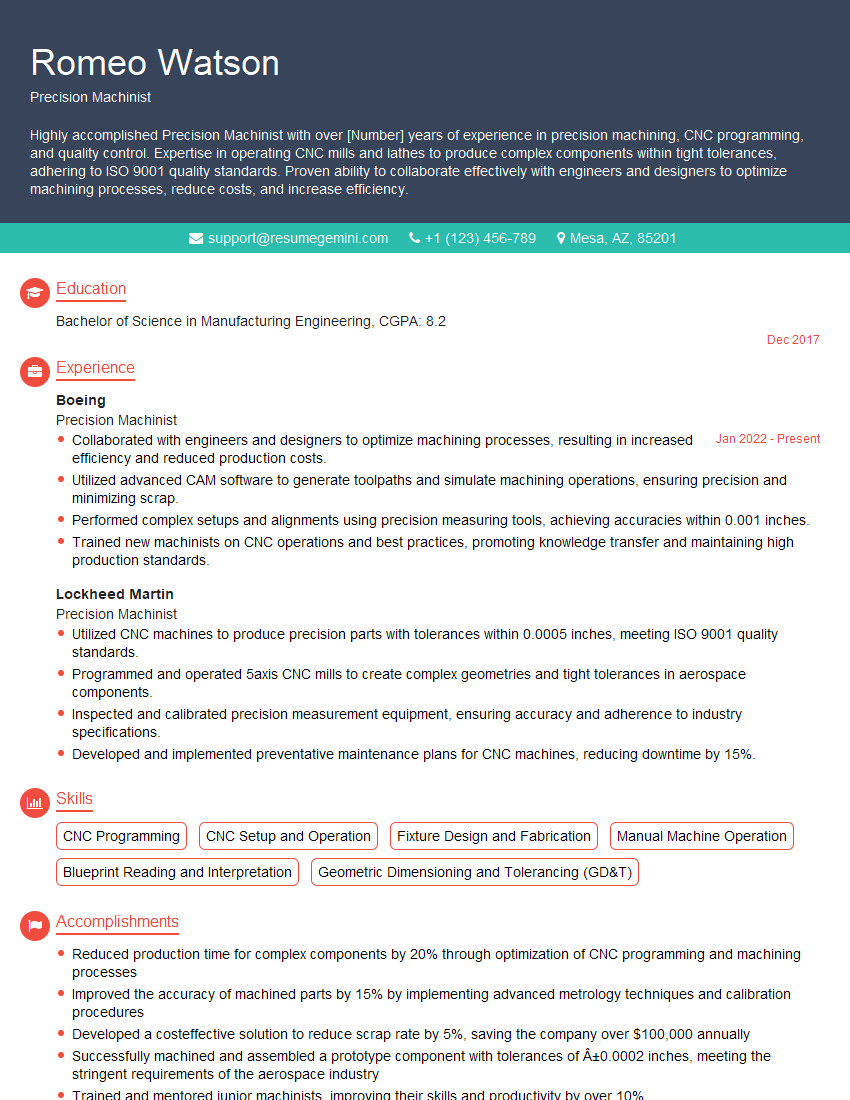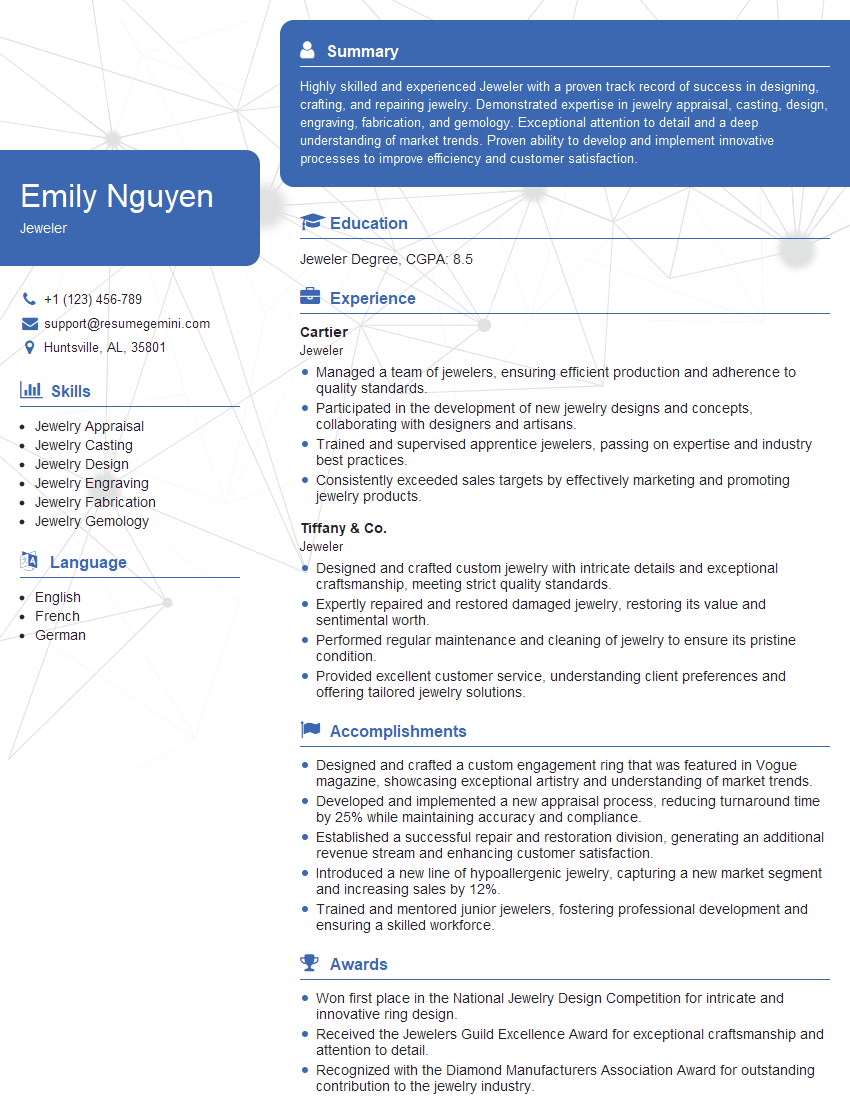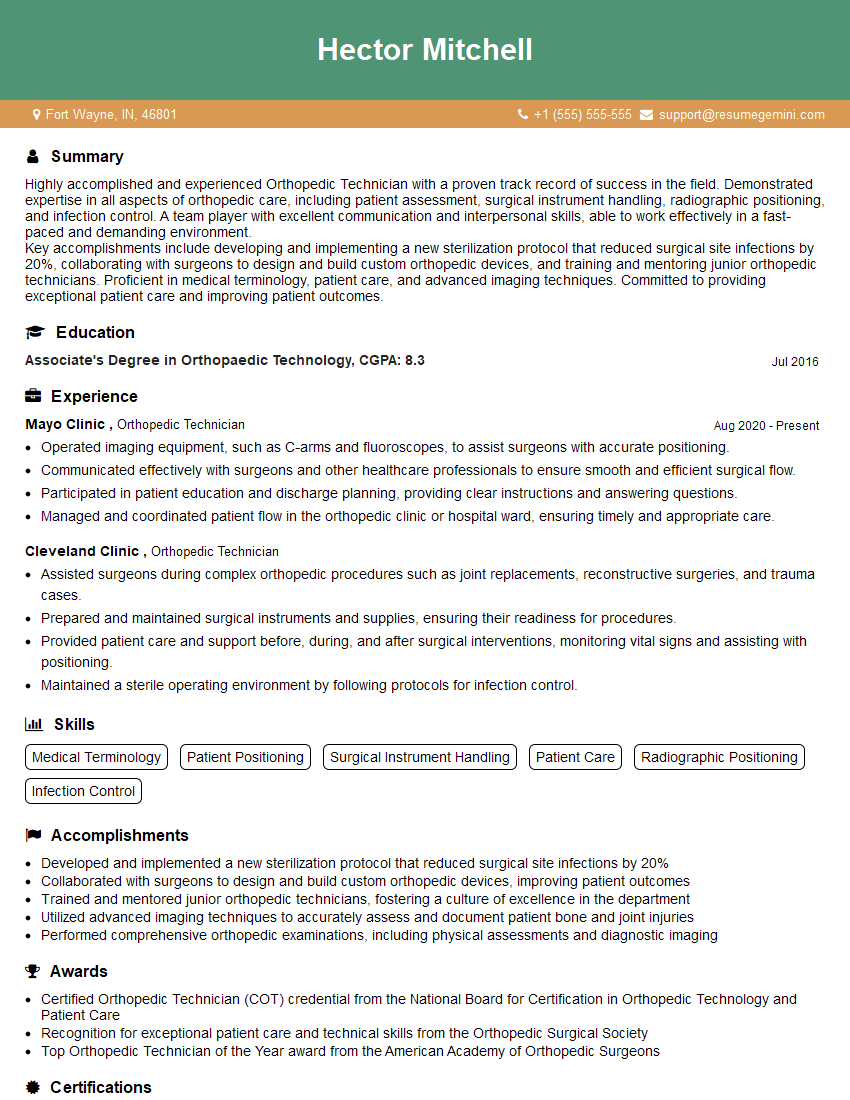Interviews are more than just a Q&A session—they’re a chance to prove your worth. This blog dives into essential Manual/Dexterity interview questions and expert tips to help you align your answers with what hiring managers are looking for. Start preparing to shine!
Questions Asked in Manual/Dexterity Interview
Q 1. Describe your experience with fine motor skills.
Fine motor skills are the intricate movements of small muscles, primarily in the hands and fingers, allowing for precise actions. My experience encompasses a wide range of tasks requiring such dexterity, from intricate micro-soldering to delicate assembly of miniature components. I’ve consistently demonstrated the ability to control hand and finger movements with accuracy and precision, essential for tasks like manipulating tiny screws, assembling complex mechanisms, and handling fragile materials without causing damage.
For instance, during my time at [Previous Company Name], I was responsible for assembling intricate sensor arrays. Each array involved dozens of minuscule components, requiring exceptional control and steady hands. My success rate consistently exceeded company standards, demonstrating my proficiency in fine motor skills.
Q 2. How do you maintain precision while performing repetitive tasks?
Maintaining precision during repetitive tasks requires a multi-pronged approach. Firstly, ergonomic posture is paramount. Maintaining proper wrist and hand positioning minimizes strain and promotes accuracy. Secondly, regular micro-breaks are crucial to prevent fatigue, which significantly impacts precision. Taking short breaks every 30-45 minutes allows for muscle relaxation and improved focus.
Thirdly, I employ mindfulness techniques. Focusing intently on the task at hand, almost meditating on each movement, helps prevent errors due to distraction or inattention. Finally, using magnifying glasses or specialized tools when necessary can greatly enhance the precision of repetitive tasks. For instance, when working with tiny screws, a jeweler’s screwdriver and a magnifying lamp significantly improve my accuracy.
Q 3. Explain a time you had to work with small or delicate parts.
In a previous project involving the repair of antique clocks, I had to work extensively with minuscule parts, including delicate springs, tiny screws, and intricate gears. The challenge lay not just in the size of the components, but in their fragility and the necessity of preserving the clock’s original functionality. I used specialized tools, like micro-tweezers and a magnifying glass, to handle the parts with care. Each movement had to be deliberate and controlled to avoid breakage. This project required patience, precision, and a deep understanding of the clock’s mechanism. The success of the repair highlighted the importance of steady hands and a meticulous approach to handling small, delicate components.
Q 4. How do you adapt your technique when faced with challenging dexterity requirements?
Adapting to challenging dexterity requirements involves a combination of strategies. First, I assess the task thoroughly, identifying the specific challenges and limitations. This often involves examining the components, tools, and workspace to determine optimal approaches. Next, I experiment with different techniques, tools, and grips to find the most effective and comfortable method. This might include adjusting the angle of my work, using specialized tools, or changing my grip to better control the components.
For example, if a task requires accessing a tight space, I might employ a flexible shaft tool or a miniature screwdriver with a bent tip. If working with unusually shaped components, I’ll adjust my grip to optimize control and leverage. This adaptive approach ensures efficient and accurate completion of the task, regardless of the dexterity challenges posed.
Q 5. Describe your experience with hand-eye coordination tasks.
Hand-eye coordination is fundamental to my work. Years of experience have honed my ability to seamlessly integrate visual input with precise motor control. Tasks ranging from assembling electronic devices to performing intricate surgical procedures (if applicable, tailor this to the specific job) rely heavily on this coordination. I regularly practice exercises that strengthen this skill, such as catching small objects or performing fine motor tasks while visually tracking a moving target.
My ability to accurately place components, align parts, and execute precise movements under visual guidance is consistently demonstrated in my work. The success of many projects hinges on this precise hand-eye coordination, showcasing its importance in my skill set.
Q 6. How do you manage fatigue during tasks requiring high levels of dexterity?
Managing fatigue during dexterity-intensive tasks requires proactive measures. Maintaining proper posture, taking regular breaks, and stretching my hands and wrists are crucial. I also prioritize sufficient sleep and hydration to optimize physical and mental stamina. Furthermore, I use techniques like mindfulness and deep breathing to manage stress and reduce muscle tension, which exacerbates fatigue.
In high-pressure situations, I consciously slow down my pace, prioritizing accuracy over speed. This deliberate approach minimizes errors and prevents burnout. Finally, I am always mindful of my physical limits and don’t hesitate to seek assistance or take additional breaks when needed.
Q 7. What strategies do you use to ensure accuracy in your work?
Ensuring accuracy in my work involves several key strategies. Firstly, I meticulously plan and organize my workspace, ensuring all necessary tools and components are within easy reach and well-organized. Secondly, I double-check each step of the process, meticulously verifying measurements, alignments, and connections. Thirdly, I regularly calibrate my tools and equipment to maintain optimal performance and prevent inaccuracies caused by malfunctioning instruments.
Finally, I utilize visual aids like magnifying glasses or microscopes when necessary, ensuring clear visibility of the components and work area. This meticulous and layered approach significantly reduces errors and enhances the overall accuracy of my work.
Q 8. How do you handle errors or mistakes when working with intricate details?
When working with intricate details, errors are inevitable. My approach focuses on proactive prevention and effective remediation. Prevention involves meticulous planning, using appropriate magnification tools (if needed), and employing a methodical, step-by-step approach. For example, before assembling a miniature clock mechanism, I carefully lay out all the components in order, using a checklist to ensure nothing is missing.
If a mistake does occur, I first assess the impact. If it’s a minor error, I’ll carefully undo the step and correct it. If it’s more significant, I might use specialized tools to delicately disassemble the affected section, correct the problem, and then carefully reassemble it. Documentation plays a vital role—I might take photos or make notes throughout the process to aid in troubleshooting. Importantly, I don’t hesitate to seek guidance from colleagues or refer to manuals if I’m unsure of the best course of action. Learning from mistakes is paramount; I thoroughly analyze what went wrong to avoid similar errors in the future.
Q 9. Explain your understanding of ergonomics and its impact on manual dexterity.
Ergonomics is the science of designing workplaces, tools, and tasks to suit the capabilities of the human body. In the context of manual dexterity, it’s crucial because it directly impacts efficiency, comfort, and injury prevention. Poor ergonomics can lead to repetitive strain injuries (RSIs), carpal tunnel syndrome, and other musculoskeletal disorders.
For example, using tools with uncomfortable grips, maintaining awkward postures for extended periods, or working in poorly lit areas can significantly strain the hands, wrists, and forearms, reducing dexterity and increasing the risk of injury. Good ergonomic practices involve using properly sized tools, maintaining a neutral wrist position, taking frequent breaks, and adjusting the workspace to optimize posture. I always prioritize proper ergonomics, ensuring my workspace is well-organized, well-lit, and supportive of my body’s natural movements.
Q 10. Describe your experience with different types of tools and equipment requiring dexterity.
My experience spans a wide range of tools and equipment, each demanding a different level of dexterity. This includes fine-tipped tweezers for microelectronics assembly, specialized surgical instruments for delicate procedures (in a simulated setting for training purposes), various hand tools for woodworking projects (requiring precision and control), and even specialized automotive tools that require fine motor skills for precise adjustments. I’m proficient in using both hand-held and power tools, understanding the limitations and capabilities of each and choosing the right tool for the job is crucial to both efficiency and safety.
For instance, while assembling a circuit board, the precision required by tweezers for placing minuscule components demands a different level of dexterity than using a screwdriver to assemble a piece of furniture. Adaptability is key – I can swiftly adjust my technique and precision based on the tool and task at hand.
Q 11. How do you maintain the necessary level of dexterity for your profession?
Maintaining dexterity requires a multifaceted approach. Regular practice and exercises are paramount. I incorporate targeted hand and finger exercises, focusing on strengthening, flexibility, and range of motion. These exercises might include hand squeezing, finger stretches, and fine motor skill activities like puzzles or playing a musical instrument. Additionally, I prioritize preventative measures such as ensuring proper posture, taking regular breaks during extended work sessions, and avoiding prolonged repetitive movements. Finally, I pay close attention to my overall health, ensuring sufficient sleep, a balanced diet, and staying hydrated—all of which contribute to hand and body health.
Q 12. Describe a time you had to improve your dexterity for a specific task.
I once had to improve my dexterity for a project involving the restoration of an antique clock. The clock’s intricate mechanism required the manipulation of extremely tiny components, some barely visible to the naked eye. My initial attempts were frustrating, leading to several minor setbacks. To improve, I practiced manipulating tiny objects like beads and sewing needles, gradually increasing the complexity of the tasks. I also invested in a high-magnification binocular microscope and specialized fine-tipped tools. Through consistent practice and utilizing the appropriate tools, I significantly improved my precision and ultimately completed the restoration successfully. This experience underscored the value of targeted practice and the importance of selecting the right tools for the task.
Q 13. What safety precautions do you take when performing tasks requiring manual dexterity?
Safety is my top priority when working with manual dexterity. This begins with proper preparation and using appropriate personal protective equipment (PPE). This might include wearing gloves to protect my hands from sharp objects or chemicals, safety glasses to prevent eye injuries from flying debris, and using anti-fatigue mats to support my feet and prevent back strain. When using tools, I ensure they are in good working order, properly maintained, and used as intended. I avoid rushing and maintain focus to prevent accidents. I always follow established safety procedures and protocols relevant to the specific task and environment.
For example, when handling sharp objects like knives or scalpels, I always use a firm, controlled grip, and I’m particularly aware of my finger placement to avoid cuts. Furthermore, I maintain a tidy and organized workspace to minimize tripping hazards and to make sure tools are easily accessible but stored safely when not in use.
Q 14. How do you measure your own level of manual dexterity?
Measuring manual dexterity isn’t a simple process, as it encompasses multiple aspects – strength, precision, coordination, and speed. While there aren’t single definitive measures, I use a combination of methods. I perform self-assessments by regularly completing tasks requiring varying levels of dexterity and reflecting on my performance. For instance, I might time myself assembling a small mechanical device or assess the accuracy of placing tiny components on a circuit board. Additionally, I track my progress on dexterity exercises and note any improvement in speed, accuracy, or range of motion. If needed, I can utilize standardized dexterity tests such as the Purdue Pegboard test or the Grooved Pegboard test; however, these provide only a snapshot of certain aspects of dexterity rather than a complete picture.
Q 15. What are the common challenges associated with maintaining high levels of manual dexterity?
Maintaining high levels of manual dexterity presents several challenges. These challenges can stem from both internal factors (like the individual’s physical condition) and external factors (like the work environment).
- Repetitive Strain Injuries (RSI): Performing repetitive movements, especially without proper breaks or ergonomic setup, significantly increases the risk of developing RSIs like carpal tunnel syndrome or tendonitis. These conditions can dramatically reduce dexterity and cause significant pain.
- Fatigue: Prolonged periods of fine motor work lead to fatigue, impacting precision and control. Even a small decrease in dexterity can lead to errors and reduced efficiency.
- Age-Related Decline: As we age, our fine motor skills and hand-eye coordination naturally decline. Maintaining peak dexterity requires conscious effort and possibly compensatory techniques.
- Environmental Factors: Working in cold environments, for example, can reduce blood flow to the hands, affecting dexterity. Similarly, vibration from tools can negatively impact hand function.
- Improper Ergonomics: Poor posture, awkward hand positions, and inadequate workspace design all contribute to reduced dexterity and increased risk of injury.
For example, a surgeon performing intricate microsurgery faces extreme pressure to maintain unwavering dexterity for extended periods. A slight tremor from fatigue can have serious consequences.
Career Expert Tips:
- Ace those interviews! Prepare effectively by reviewing the Top 50 Most Common Interview Questions on ResumeGemini.
- Navigate your job search with confidence! Explore a wide range of Career Tips on ResumeGemini. Learn about common challenges and recommendations to overcome them.
- Craft the perfect resume! Master the Art of Resume Writing with ResumeGemini’s guide. Showcase your unique qualifications and achievements effectively.
- Don’t miss out on holiday savings! Build your dream resume with ResumeGemini’s ATS optimized templates.
Q 16. How do you assess the level of dexterity needed for a specific job or task?
Assessing the dexterity needed for a specific job involves a multi-faceted approach combining observation, testing, and job analysis.
- Job Analysis: Carefully analyze the task. What are the specific movements involved? What level of precision is required? How much force is needed? What is the duration of the task?
- Observation: Observe experienced workers performing the task. This provides insights into the actual dexterity demands of the job, including subtle movements or techniques not immediately apparent.
- Dexterity Tests: Various standardized tests (e.g., Purdue Pegboard Test, Grooved Pegboard Test) can quantitatively assess fine motor skills, speed, and coordination. These tests provide objective data supplementing observations.
- Simulated Tasks: Creating a realistic simulation of the task allows candidates to demonstrate their abilities in a controlled environment. This can be particularly helpful for complex tasks.
Consider a watchmaker. A job analysis would highlight the need for exceptional fine motor skills to manipulate tiny components. Observing a skilled watchmaker would reveal their hand techniques. A dexterity test would provide objective data on their speed and precision with small objects.
Q 17. How do you handle situations where your dexterity is compromised (e.g., injury or fatigue)?
When dexterity is compromised, the immediate priority is to address the underlying cause. This may involve seeking medical attention for injuries or implementing strategies to manage fatigue.
- Medical Attention: Injuries require professional medical evaluation and treatment. This may include physical therapy, medication, or surgery. Following medical advice is crucial for recovery.
- Rest and Recovery: Fatigue necessitates adequate rest breaks and sufficient sleep. Avoiding prolonged periods of strenuous work is vital.
- Ergonomic Adjustments: Modifying the workspace to minimize strain and promote proper posture can significantly improve comfort and dexterity.
- Assistive Devices: Tools like magnifying glasses, specialized grips, or wrist supports can help compensate for reduced dexterity.
- Modified Tasks: If necessary, the task itself can be modified to lessen the dexterity demands. This may involve automation or simplifying certain steps.
For instance, if I experience carpal tunnel symptoms, I’d immediately seek medical advice and adjust my workspace ergonomics. This might include using a wrist splint and taking frequent breaks.
Q 18. What are some techniques for improving hand-eye coordination and fine motor skills?
Improving hand-eye coordination and fine motor skills requires consistent practice and targeted exercises.
- Targeted Exercises: Activities like playing musical instruments, knitting, or using dexterity training tools strengthen hand muscles and improve coordination. Simple exercises like picking up small objects or tracing intricate patterns are beneficial.
- Hand Strengthening: Exercises using hand grippers or putty can improve grip strength and fine motor control.
- Eye Exercises: Focus exercises, such as following a moving object with your eyes or focusing on objects at varying distances, improve eye-hand coordination.
- Cognitive Training: Activities that challenge cognitive skills, such as puzzles or video games requiring precise movements, indirectly improve dexterity.
- Professional Guidance: Physical therapists or occupational therapists can design personalized programs to address specific needs and deficits.
I personally practice finger exercises regularly, playing the piano to enhance dexterity and coordination.
Q 19. Describe your experience with using specialized tools or equipment that require high levels of dexterity.
My experience includes working with various specialized tools requiring high dexterity, including:
- Microsurgery Instruments: Working with delicate instruments requiring extreme precision and stability during microsurgery procedures.
- Dental Instruments: Using a range of instruments for detailed dental procedures, requiring steady hands and accurate movements.
- Electronic Assembly Tools: Working with miniature components in electronic assembly, demanding a high level of fine motor control.
- Jewelry-Making Tools: Using tools like tweezers, pliers, and specialized files for intricate jewelry crafting.
Each tool necessitates a different set of techniques and demands a different level of fine motor control. Using microsurgery instruments, for example, requires a very steady hand and precise movements to avoid damaging delicate tissues.
Q 20. How do you prioritize speed and accuracy when performing tasks requiring dexterity?
Prioritizing speed and accuracy is a constant balancing act. It’s not about choosing one over the other, but rather finding an optimal balance. A rushed job is often an inaccurate one.
- Practice and Training: Consistent practice allows for automation of movements, increasing speed without sacrificing accuracy. Training focuses on techniques that optimize efficiency.
- Ergonomics: A well-organized workspace minimizes unnecessary movements, streamlining the process and increasing both speed and accuracy.
- Mental Focus: Maintaining concentration is crucial. Distractions lead to errors and reduce speed. Mindfulness and meditation can help maintain focus.
- Breakdowns: Breaking down complex tasks into smaller, more manageable steps reduces the mental load and improves both efficiency and accuracy.
- Self-Assessment: Regularly assess performance to identify areas for improvement and refine techniques.
In any task requiring dexterity, whether assembling a complex electronic circuit or performing surgery, speed and accuracy are intertwined. Practicing to achieve the optimal balance is key.
Q 21. How do you ensure your work meets high quality standards when working with your hands?
Ensuring high-quality work involves a commitment to precision, attention to detail, and continuous improvement.
- Quality Control Checks: Implementing regular checks throughout the process, identifying and correcting errors early, minimizes rework and ensures consistency.
- Use of appropriate tools: Employing the right tools for the job is crucial. Using blunt instruments or poorly maintained equipment can lead to damage and errors.
- Proper Technique: Following established procedures and techniques ensures consistency and quality. This includes adhering to safety protocols.
- Continuous Improvement: Seeking feedback and regularly reviewing work practices identifies areas for improvement and enhances skills over time.
- Self-Reflection: Analyzing completed work to identify strengths and weaknesses, learning from mistakes, and adapting techniques.
For example, in jewelry making, a meticulous inspection after each step ensures that flaws are caught early. This meticulous approach results in a final product that meets the highest standards.
Q 22. What are some common causes of errors in tasks requiring manual dexterity?
Errors in tasks requiring manual dexterity stem from a variety of sources, often interacting in complex ways. These can be broadly categorized into issues with the individual, the task itself, and the environment.
- Individual Factors: These include fatigue, lack of sleep, stress, pre-existing conditions like arthritis or carpal tunnel syndrome, inadequate training, and simply a lack of experience. For example, a surgeon performing a delicate procedure after a long shift is more prone to errors due to fatigue.
- Task-Related Factors: The complexity of the task, the required precision, the repetition involved, and the time constraints all contribute to errors. A repetitive assembly line task, if poorly designed, can lead to increased errors as the worker tires. Similarly, a task requiring extremely fine motor control, like micro-surgery, requires a high level of skill and concentration, increasing the risk of errors if not properly executed.
- Environmental Factors: Poor lighting, uncomfortable workspace ergonomics, inadequate tools, and distractions in the workplace can significantly impact dexterity and increase error rates. A poorly lit workspace can lead to misjudgments of distances and angles, resulting in errors in tasks requiring precision.
Q 23. How do you troubleshoot problems that arise due to limitations in manual dexterity?
Troubleshooting dexterity-related problems requires a systematic approach. It’s crucial to identify the root cause before implementing solutions. My approach involves:
- Identifying the Error: First, pinpoint the specific nature of the error. Is it inconsistent accuracy, speed issues, or a recurring pattern of mistakes? Detailed observation is key here. For example, if a watchmaker consistently misplaces a tiny gear, it might indicate a vision problem, poor lighting, or a need for better magnification.
- Analyzing the Task: Evaluate the task itself. Is it too complex for the individual’s skill level? Are the tools appropriate? Could the workflow be improved? Perhaps redesigning a repetitive task to be less strenuous might help prevent errors.
- Assessing the Individual: Consider the individual’s physical and mental state. Are there any underlying health issues impacting their dexterity? Are they adequately trained? Providing training or adjustments to the workstation can improve the overall situation. A simple adjustment of chair height can drastically change the worker’s ability to work effectively.
- Environmental Review: Inspect the workspace. Is the lighting sufficient? Is the workstation ergonomically sound? Are there excessive distractions? Addressing these factors can often significantly reduce errors.
- Implementing Solutions: Based on the analysis, implement solutions like providing better tools, adjusting the workspace, providing additional training, or addressing any health concerns. Sometimes, a simple change, like providing a magnifying glass, can dramatically improve precision.
Q 24. How do you train or mentor others in developing their manual dexterity skills?
Training others in manual dexterity involves a multi-faceted approach focusing on both theoretical understanding and practical application. I emphasize:
- Gradual Progression: Start with basic exercises that build fundamental skills like hand-eye coordination and fine motor control. I often start with simple tasks, gradually increasing complexity as skills improve. Think of learning to play the piano: starting with simple scales before complex pieces.
- Repetition and Practice: Consistent practice is crucial for skill development. I incorporate repetitive tasks, but with a focus on quality over speed. Proper repetition, with feedback and correction, is essential for skill development and refinement.
- Feedback and Correction: Regular feedback is vital. I observe trainees closely, providing constructive criticism and identifying areas for improvement. I focus on positive reinforcement to build confidence and encourage continued effort.
- Ergonomics and Safety: I teach proper posture and hand techniques to minimize risk of injury and improve efficiency. I emphasize maintaining a neutral wrist position and avoiding repetitive strain.
- Real-World Application: I integrate training with real-world scenarios, allowing trainees to practice skills in relevant contexts. I simulate realistic work scenarios to ensure trainees can apply the techniques to actual jobs.
Q 25. Describe your experience with working under pressure while performing tasks requiring dexterity.
Working under pressure while performing dexterity-based tasks requires a calm and focused approach. My experience has taught me the importance of preparation and efficient time management.
In one instance, I was tasked with repairing a critical piece of equipment during an operational emergency. Time was of the essence, and the pressure was immense. My strategy involved breaking down the task into smaller, manageable steps, focusing on one step at a time to maintain accuracy and avoid mistakes. Deep breathing techniques helped manage stress and maintain focus. I also relied on my experience to visualize the repair process and anticipate potential problems.
I’ve found that thorough preparation—understanding the task completely, having the right tools readily available, and practicing similar scenarios beforehand—significantly reduces anxiety and improves performance under pressure.
Q 26. What are your strengths and weaknesses regarding manual dexterity?
My strengths lie in my fine motor control, precision, and ability to maintain focus under pressure. I have a good sense of spatial awareness, which is crucial in many dexterity-based tasks. I’m also adept at adapting my techniques to different situations and tools.
However, like everyone, I have weaknesses. Extended periods of repetitive tasks can lead to fatigue and reduced accuracy. I actively work to mitigate this by taking breaks and employing ergonomic strategies.
Q 27. How do you maintain a healthy and functional hand and arm structure?
Maintaining healthy hands and arms is crucial for sustained dexterity. My approach involves:
- Regular Exercise: I perform exercises that strengthen hand and forearm muscles, improve flexibility, and promote blood circulation. These include simple stretches and hand strengthening exercises.
- Ergonomic Practices: I maintain good posture, use ergonomic tools and equipment, and take frequent breaks to avoid fatigue and repetitive strain injuries.
- Proper Nutrition and Hydration: A balanced diet and adequate hydration support overall health and contribute to joint health and muscle function.
- Rest and Recovery: Sufficient sleep and regular rest periods are essential for muscle recovery and preventing injuries.
- Professional Care: I consult with healthcare professionals if I experience any discomfort or pain in my hands or arms. Early intervention is key in preventing long-term issues.
Q 28. How do you adapt your workspace to optimize your manual dexterity performance?
Optimizing my workspace for manual dexterity involves several key considerations:
- Ergonomic Setup: I ensure my chair is at the correct height, my keyboard and mouse are within easy reach, and my workspace is well-organized to minimize unnecessary movements. My workstation is arranged to minimize awkward postures and unnecessary stretching.
- Adequate Lighting: Sufficient, well-placed lighting minimizes eye strain and improves precision. Proper lighting is crucial for fine detail work.
- Organized Tools and Materials: Frequently used tools and materials are easily accessible. This reduces reaching and unnecessary movements, making the workflow more efficient.
- Comfortable Temperature: A comfortable room temperature prevents discomfort and improves focus. Extreme temperatures can affect hand dexterity.
- Minimal Distractions: A quiet workspace free from interruptions minimizes errors and improves focus.
Key Topics to Learn for Manual/Dexterity Interview
- Fine Motor Skills & Precision: Understanding the nuances of hand-eye coordination, dexterity levels, and their application in various tasks. Consider exploring different assessment methods for evaluating these skills.
- Ergonomics and Safety: Learn about proper posture, hand positioning, and tool usage to prevent injuries and maintain efficiency. Discuss practical applications like workstation setup and risk assessment.
- Tool Proficiency and Maintenance: Demonstrate knowledge of various hand tools, their applications, and proper maintenance procedures. Be prepared to discuss experience with specific tools relevant to your target roles.
- Assembly and Disassembly Techniques: Understand the principles of efficient assembly and disassembly processes, including the use of jigs, fixtures, and specialized equipment. Prepare examples of your experience with complex assemblies.
- Troubleshooting and Problem-Solving: Discuss approaches to identifying and resolving issues related to manual dexterity tasks. Highlight your ability to adapt to changing situations and find creative solutions.
- Quality Control and Inspection: Explain your understanding of quality standards and procedures related to manual tasks. Be ready to describe your experience with inspection techniques and defect identification.
- Production Efficiency and Optimization: Discuss strategies for improving efficiency and output in manual tasks. Explore methods for streamlining processes and reducing errors.
Next Steps
Mastering manual dexterity skills opens doors to a wide range of rewarding careers, offering opportunities for growth and specialization. A strong resume is crucial for showcasing your abilities to potential employers. Crafting an ATS-friendly resume increases your chances of getting noticed by recruiters. We highly recommend using ResumeGemini to build a professional and effective resume that highlights your skills and experience. ResumeGemini provides examples of resumes tailored to Manual/Dexterity roles to help you create a compelling application.
Explore more articles
Users Rating of Our Blogs
Share Your Experience
We value your feedback! Please rate our content and share your thoughts (optional).
What Readers Say About Our Blog
Hello,
We found issues with your domain’s email setup that may be sending your messages to spam or blocking them completely. InboxShield Mini shows you how to fix it in minutes — no tech skills required.
Scan your domain now for details: https://inboxshield-mini.com/
— Adam @ InboxShield Mini
Reply STOP to unsubscribe
Hi, are you owner of interviewgemini.com? What if I told you I could help you find extra time in your schedule, reconnect with leads you didn’t even realize you missed, and bring in more “I want to work with you” conversations, without increasing your ad spend or hiring a full-time employee?
All with a flexible, budget-friendly service that could easily pay for itself. Sounds good?
Would it be nice to jump on a quick 10-minute call so I can show you exactly how we make this work?
Best,
Hapei
Marketing Director
Hey, I know you’re the owner of interviewgemini.com. I’ll be quick.
Fundraising for your business is tough and time-consuming. We make it easier by guaranteeing two private investor meetings each month, for six months. No demos, no pitch events – just direct introductions to active investors matched to your startup.
If youR17;re raising, this could help you build real momentum. Want me to send more info?
Hi, I represent an SEO company that specialises in getting you AI citations and higher rankings on Google. I’d like to offer you a 100% free SEO audit for your website. Would you be interested?
Hi, I represent an SEO company that specialises in getting you AI citations and higher rankings on Google. I’d like to offer you a 100% free SEO audit for your website. Would you be interested?
good

